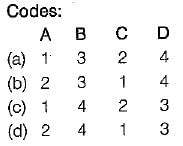Test: Modem Digital Modulation & Detection Techniques - Electronics and Communication Engineering (ECE) MCQ
10 Questions MCQ Test GATE ECE (Electronics) Mock Test Series 2025 - Test: Modem Digital Modulation & Detection Techniques
Assertion (A): Binary phase shift keying (BPSK) is the most efficient of the three digital modulation, i.e., ASK, FSK and PSK.
Reason (R): In BPSK, phase of sinusoidal carrier is changed according to the data bit to be transmitted.
Reason (R): In BPSK, phase of sinusoidal carrier is changed according to the data bit to be transmitted.
Which of the following modulation scheme is most affected by noise?
| 1 Crore+ students have signed up on EduRev. Have you? Download the App |
Match List-I with List-ll and select the correct answer using the codes given below the lists:
List-I
A. BPSK
B. AM
C. QPSK
D. ASK
List-ll
1. A group of two binary bits is represented by one phase state.
2. A binary bit is represented by one phase state.
3. Carrier ON or OFF depending on whether ‘V or ‘0’ is to be transmitted.
4. Detected using envelope detector

A. BPSK
B. AM
C. QPSK
D. ASK
1. A group of two binary bits is represented by one phase state.
2. A binary bit is represented by one phase state.
3. Carrier ON or OFF depending on whether ‘V or ‘0’ is to be transmitted.
4. Detected using envelope detector

The bit rate of a digital communication system is 34 Mbps. The modulation scheme is QPSK. The baud rate of the system is
Consider the following statements;
1. BPSK has a bandwidth which is lower than that of a BFSK signal.
2. BPSK yields the maximum value of probability of error compared to ail the three digital modulation techniques i.e. ASK, FSK and PSK.
3. Binary FSK has the highest system complexity.
4. Binary ASK is demodulated using coherent detection while binary FSK and PSK are demodulated using envelope detection
Which of the statements given above are correct?
Comparison of MSKand QPSK scheme shows that
In a digital continuous-time communication system, the bit rate of NRZ data stream is 1 Mbps and carrier frequency of transmission is 100 MHz. What is the bandwidth requirement of the channel in BPSK and QPSK systems respectively?
The error probability of QPSK is
Bandwidth of BPSK is ___ than that of BFSK.
The error probability of QPSK is
|
25 docs|263 tests
|
|
25 docs|263 tests
|





















